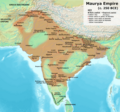File:Maurya Empire, c.250 BCE.png

預覽大小:642 × 600 像素。 其他解析度:257 × 240 像素 | 514 × 480 像素 | 822 × 768 像素 | 1,200 × 1,121 像素。
原始檔案 (1,200 × 1,121 像素,檔案大小:2.3 MB,MIME 類型:image/png)
檔案歷史
點選日期/時間以檢視該時間的檔案版本。
| 日期/時間 | 縮圖 | 尺寸 | 使用者 | 備註 | |
|---|---|---|---|---|---|
| 目前 | 2024年1月29日 (一) 02:15 |  | 1,200 × 1,121(2.3 MB) | Avantiputra7 | as per discussions added labelling of provinces |
| 2023年11月22日 (三) 06:40 |  | 1,200 × 1,121(2.06 MB) | Avantiputra7 | Reverted to version as of 05:59, 22 November 2023 (UTC) no justification for changing to less legible version of exactly the same map | |
| 2023年11月22日 (三) 06:14 |  | 1,500 × 1,309(2.93 MB) | Indo12122 | Reverted to version as of 05:34, 22 November 2023 (UTC) Stop hijacking. | |
| 2023年11月22日 (三) 05:59 |  | 1,200 × 1,121(2.06 MB) | Avantiputra7 | Reverted to version as of 05:06, 22 November 2023 (UTC) | |
| 2023年11月22日 (三) 05:34 |  | 1,500 × 1,309(2.93 MB) | Indo12122 | Reverted to version as of 19:00, 21 November 2023 (UTC) | |
| 2023年11月22日 (三) 05:06 |  | 1,200 × 1,121(2.06 MB) | Avantiputra7 | Reverted to version as of 18:13, 21 November 2023 (UTC) rv vandalism | |
| 2023年11月21日 (二) 19:00 |  | 1,500 × 1,309(2.93 MB) | Indo12122 | Reverted to version as of 17:53, 21 November 2023 (UTC) Adding Gedrosia .Ray, Himanshu Prabha (2003). The Archaeology of Seafaring in Ancient South Asia. Cambridge University Press. ISBN 978-0-521-01109-9. In spite of the vagueness of the historical texts, the consensus among scholars is that the treaty concluded between Candragupta Maurya and Seleucus acknowledged Indian control of territories to the west of the Indus. These included Gedrosia, Paropamisadae (the region of Kabul and Begram) a... | |
| 2023年11月21日 (二) 18:13 |  | 1,200 × 1,121(2.06 MB) | Avantiputra7 | Reverted to version as of 17:07, 21 November 2023 (UTC) no justification for changing to less legible version of exactly the same map | |
| 2023年11月21日 (二) 17:53 |  | 1,500 × 1,309(2.93 MB) | Indo12122 | Reverted to version as of 16:58, 21 November 2023 (UTC) | |
| 2023年11月21日 (二) 17:07 |  | 1,200 × 1,121(2.06 MB) | Avantiputra7 | Reverted to version as of 16:36, 21 November 2023 (UTC) |
檔案用途
下列頁面有用到此檔案:
全域檔案使用狀況
以下其他 wiki 使用了這個檔案:
- bh.wikipedia.org 的使用狀況
- en.wikipedia.org 的使用狀況
- en.wiktionary.org 的使用狀況
- hy.wikipedia.org 的使用狀況
- ko.wikipedia.org 的使用狀況
- sv.wikipedia.org 的使用狀況
- ta.wikipedia.org 的使用狀況

